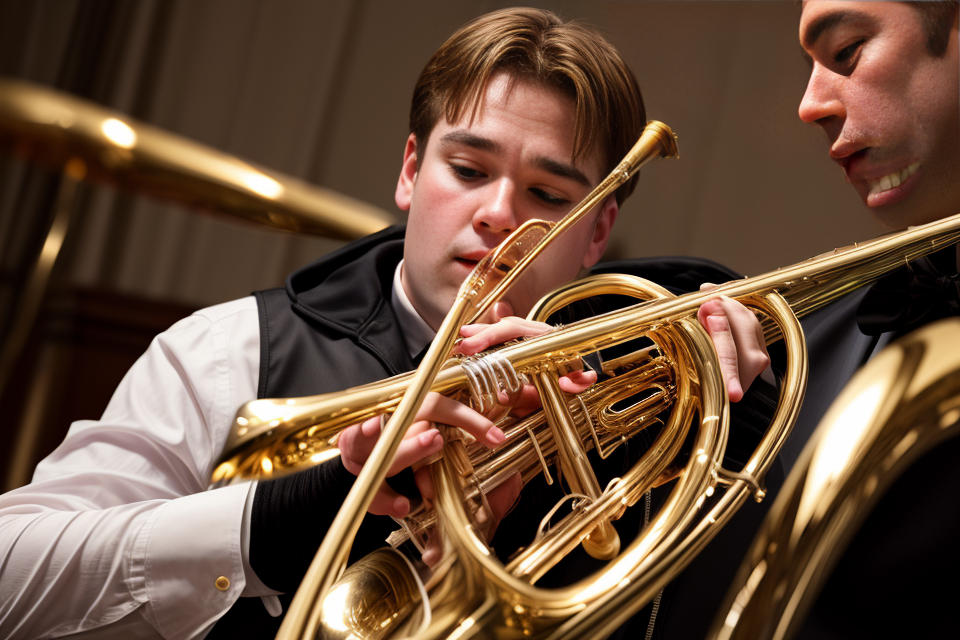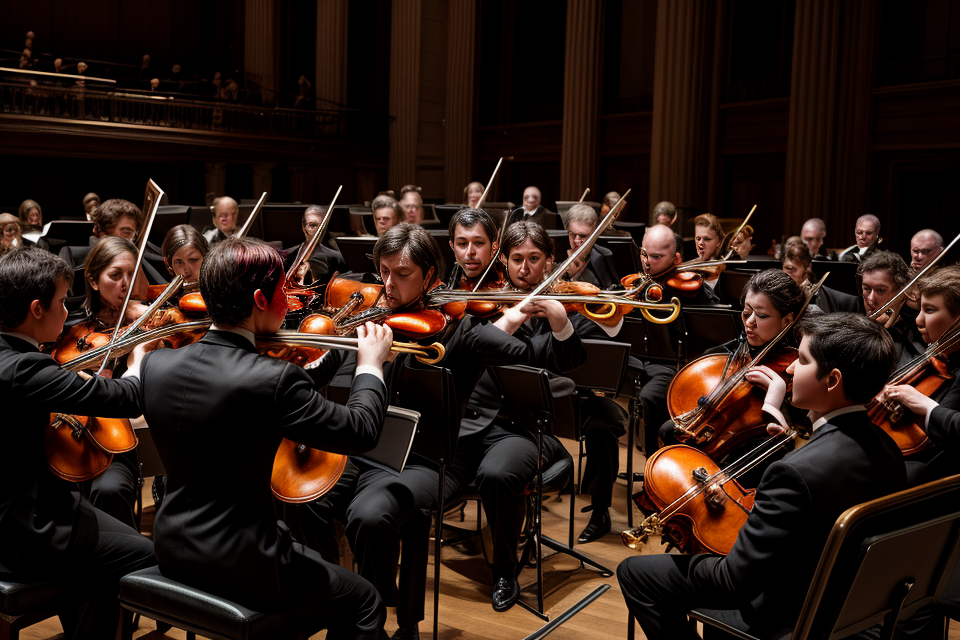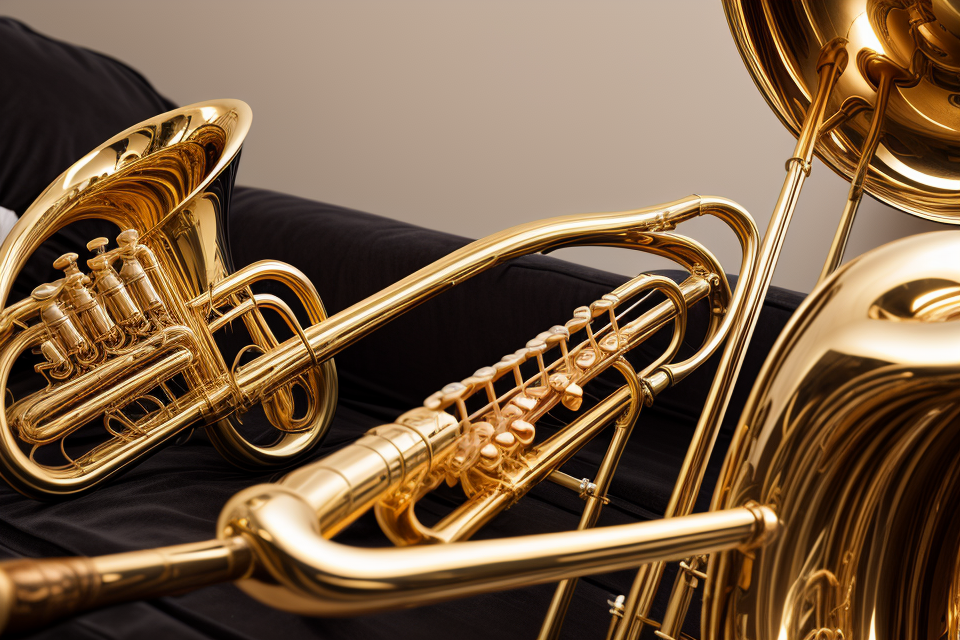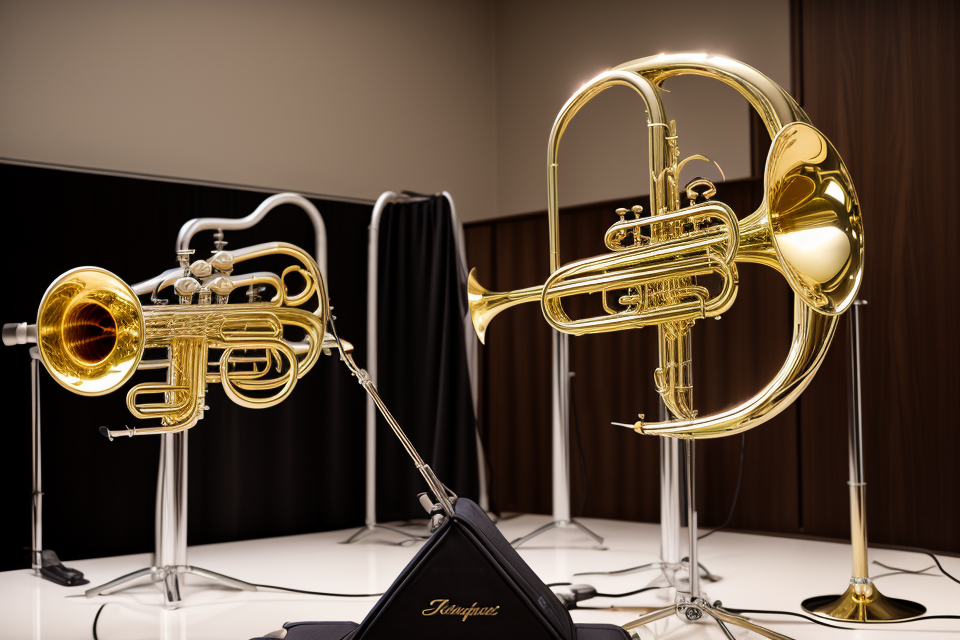The trombone is a brass instrument that has been around for centuries, but it is still a mystery to many. Its unique shape and sound have made it a staple in many genres of music, from classical to jazz. But what exactly is a trombone used for? In this article, we will explore the various roles of the trombone in music and its importance in different genres. Whether you are a musician or just a fan of music, this article will give you a deeper understanding of this fascinating instrument. So, let’s dive in and discover the magic of the trombone!
What is a Trombone?
The History of the Trombone
- The trombone is a brass instrument that has its roots in the Renaissance period.
- It evolved from the sackbut, which was a predecessor to the modern trombone.
- The trombone gained popularity and recognition in Europe during the 15th and 16th centuries.
The Structure of a Trombone
- The main components of a trombone include the mouthpiece, slide, and bell.
- The design and materials used for construction play a significant role in the sound and quality of the instrument.
- There are different types of trombones, including tenor, bass, alto, and contrabass, each with unique characteristics and purposes.
How is a Trombone Played?
The Mouthpiece and Lip Vibrations
To produce sound on a trombone, the player must create lip vibrations by buzzing their lips against the mouthpiece. This technique is similar to the way a vocalist would produce sound by vibrating their vocal cords.
There are several techniques for producing sound on a trombone, including buzzing, lip trills, and slide effects. The player can also control the pitch of the sound by changing the tension of their lips and the shape of their embouchure (the area around the mouthpiece).
The role of lip vibrations in creating different tones is significant. By varying the tension and shape of their embouchure, the player can produce a wide range of tones, from low and dark to high and bright. Additionally, the player can use different techniques to produce different articulations, such as legato and staccato.
Breath control and air pressure are also crucial factors in playing the trombone. The player must control their breath to produce a steady airflow through the instrument, and they must use the correct amount of air pressure to produce the desired volume and tone.
The Slide and Its Functionality
The slide is the main mechanism for changing the pitch of the trombone. The player moves the slide to change the length of the instrument, which in turn changes the pitch. The player can move the slide with their right hand while holding the instrument with their left hand.
To stabilize the pitch, the player can use the slide lock, which prevents the slide from moving during play. This allows the player to play in tune and with precision.
Faster slide movements are used for legato playing, where the notes are connected by a smooth, continuous sound. Slower slide movements are used for staccato playing, where the notes are separated by distinct, articulated sounds.
In addition to the slide, the trombone has several other features that allow the player to control the sound, such as the valve and the tuning slide. These features allow the player to fine-tune the instrument and produce a wide range of tones and effects.
What is the Role of a Trombone in an Orchestra?
Trombone Parts in Orchestra Music
The trombone is an essential instrument in the modern symphony orchestra, with its unique sound and versatile range contributing to the rich tapestry of sound that characterizes this musical ensemble. In this section, we will delve into the specific roles that the trombone plays in orchestral music, including its melodic and harmonic contributions, its importance in various musical genres, and its collaboration with other instruments in the orchestra.
Melodic and Harmonic Roles in Various Musical Genres
The trombone is capable of playing both melodic and harmonic roles in different musical genres. In classical music, the trombone often plays a supporting role, providing harmonic depth and texture to the music. It can play the melody in certain pieces, particularly in jazz and blues music, where it often takes center stage. In other musical genres, such as rock and pop, the trombone is used primarily for its unique sound and ability to add a sense of drama and intensity to the music.
Importance of Trombone Parts in Symphonies, Concertos, and Operas
The trombone has a particularly important role in symphonies, concertos, and operas. In these works, the trombone provides a rich and sonorous bass line, which forms the foundation of the music. It also plays a key role in creating a sense of drama and tension, particularly in the climactic moments of a piece. In addition, the trombone often plays a prominent role in the orchestral brass section, providing a bright and powerful sound that cuts through the rest of the ensemble.
Collaboration with Other Instruments in the Orchestra
The trombone is a versatile instrument that can collaborate with other instruments in the orchestra in a variety of ways. It can play off the sound of the trumpet, creating a bright and sparkling sound, or blend with the rich, warm sound of the cello. It can also provide a contrast to the sharp, piercing sound of the violin or the smooth, mellow sound of the clarinet. This collaboration with other instruments is a key aspect of the trombone’s role in the orchestra, as it contributes to the overall balance and texture of the music.
Jazz and Popular Music
Trombone’s Role in Jazz and Swing Music
In jazz and swing music, the trombone plays a crucial role as a rhythm section instrument. Its unique sound and range make it a versatile instrument that can play a variety of parts, from simple rhythm patterns to complex harmonies. Trombones are often used in big bands and jazz ensembles to provide a full, rich sound and to create a sense of excitement and energy in the music.
Trombone Soloists and Their Contributions to Jazz and Popular Music
Many famous jazz and popular music soloists have been trombonists, including Louis Armstrong, Glenn Miller, and Jack Teagarden. These musicians used the trombone to create solos that were both technically impressive and musically expressive. They incorporated elements of swing, blues, and other styles into their playing, creating a unique sound that was distinctly American.
The Use of the Trombone in Modern Music and Its Impact on Different Genres
Today, the trombone continues to be an important instrument in many different genres of music. In jazz, trombones are often used to add a brassy, upbeat sound to the ensemble. In popular music, trombones are sometimes used to create a retro or nostalgic feel, as they were often featured in the music of the 1950s and 1960s. In classical music, the trombone is a staple of the orchestra and is used to add depth and richness to the sound. Overall, the trombone remains an important and versatile instrument in many different styles of music.
Solo Performance and Improvisation
- Trombone as a solo instrument
The trombone is an essential part of an orchestra and is often featured as a solo instrument in various pieces. It is known for its distinct sound and range, which allows it to create unique melodies and harmonies that blend well with other instruments. The trombone’s versatility makes it an ideal instrument for showcasing a wide range of emotions and expressions in a solo performance. - Techniques for improvisation and expressive playing
Trombone players have the ability to improvise and express themselves through their playing. They use various techniques such as slide positions, mutes, and embellishments to create unique sounds and styles. Improvisation is a significant aspect of jazz music, and the trombone is a popular choice among jazz musicians due to its versatility and the ability to create a wide range of tones and timbres. - Notable trombone soloists and their performances
Throughout history, there have been many notable trombone soloists who have made significant contributions to the instrument’s role in music. Some of the most famous trombone soloists include Louis Armstrong, who was known for his distinctive playing style and improvisational skills, and Glenn Miller, who was a renowned composer and bandleader who featured the trombone prominently in his music. Other notable trombone soloists include Jack Teagarden, Bill Watrous, and Dave Bartholomew, who have all made significant contributions to the instrument’s role in music.
Tips for Playing the Trombone
Warm-Up Exercises and Breath Control
Importance of warm-up exercises for trombone players
Warm-up exercises are crucial for trombone players to prevent injury and prepare their instruments for playing. These exercises help to stretch and warm up the muscles in the lips, tongue, and throat, which are essential for producing sound on the trombone. Warm-up exercises also help to improve breath control and overall technique.
Breath control techniques for efficient and effective playing
Breath control is a critical aspect of trombone playing, as it affects the tone, articulation, and overall sound quality. Trombone players must learn to control their breathing to achieve a smooth and even tone, as well as to articulate notes cleanly. Breath control can be improved through various techniques, such as practicing slow and fast scales, using a breathing machine, and practicing long tones.
Different breathing methods for different styles of playing
There are different breathing methods for different styles of playing, such as classical and jazz. Classical players tend to use a more consistent and controlled breathing technique, while jazz players often use a more relaxed and improvisational approach. Trombone players should experiment with different breathing techniques to find what works best for their style and technique.
Scales, Arpeggios, and Technical Exercises
Scale and arpeggio exercises for improving technique and range
Scales and arpeggios are essential exercises for improving technique and range on the trombone. Scales help to develop finger dexterity and coordination, while arpeggios help to develop range and accuracy. Practicing scales and arpeggios with a metronome can help to improve accuracy and precision, while practicing them without a metronome can help to develop a more expressive and musical tone.
Importance of practicing with a metronome for accuracy and precision
Practicing with a metronome is crucial for developing accuracy and precision on the trombone. A metronome helps to maintain a steady tempo and rhythm, which is essential for playing in ensembles and with other musicians. Trombone players should practice with a metronome to improve their timing and accuracy, as well as to develop a more consistent and controlled tone.
Exercises for developing legato and staccato playing
Legato and staccato playing are two essential techniques for trombone players. Legato playing involves playing notes smoothly and connected, while staccato playing involves playing notes short and detached. Trombone players can develop their legato and staccato playing through various exercises, such as long tones, lip slurs, and accent studies. These exercises help to improve tone quality, articulation, and overall technique on the trombone.
Famous Trombone Players and Their Contributions
Legendary Trombone Players
- Glenn Miller
- Glenn Miller was a jazz trombonist and composer during the swing era of the 1930s and 1940s.
- He formed his own band, the Glenn Miller Orchestra, which became one of the most popular bands of the era.
- Miller’s trombone playing was characterized by his use of the “growl” technique, which involved using the lower register of the instrument to create a distinctive sound.
- Louis Armstrong
- Louis Armstrong was a jazz trumpeter and singer, but he also played trombone on several of his recordings.
- Armstrong’s approach to trombone playing was influenced by his background in New Orleans jazz, and he often used the instrument to create call-and-response phrases with other musicians.
- Armstrong’s contributions to jazz as a whole, including his use of the trombone, have been recognized with numerous awards and honors.
- Kai Winding
- Kai Winding was a Danish jazz trombonist who played in a variety of styles, including bebop and cool jazz.
- Winding was known for his ability to play complex harmonies and chord progressions on the trombone, and he often used the instrument to create lush, harmonically rich textures.
- J.J. Johnson
- J.J. Johnson was an American jazz trombonist who played in a hard bop style during the 1950s and 1960s.
- Johnson was known for his use of the upper register of the trombone, and he often employed fast, virtuosic playing techniques to create complex melodic lines.
- Bob Brookmeyer
- Bob Brookmeyer was an American jazz trombonist who played in a variety of styles, including bebop and chamber jazz.
- Brookmeyer was known for his use of the valve trombone, which allowed him to play higher notes with greater ease than on a traditional trombone.
- He also developed a technique called “overtone tapping,” which involved tapping harmonics on the instrument to create complex sounds.
Modern Trombone Players
- Chris Martin
- Chris Martin is an American jazz trombonist who has played with a variety of prominent musicians, including Wynton Marsalis and the Lincoln Center Jazz Orchestra.
- Martin is known for his ability to play in a variety of styles, including hard bop, swing, and Afro-Cuban jazz.
- He has also made significant contributions to the development of jazz pedagogy, having taught at several universities and conservatories.
- Wycliffe Gordon
- Wycliffe Gordon is a American jazz trombonist and composer who has played with a variety of prominent musicians, including the Lincoln Center Jazz Orchestra and the WDR Big Band.
- Gordon is known for his ability to play in a variety of styles, including hard bop, swing, and traditional New Orleans jazz.
- Michael Davis
- Michael Davis is an American jazz trombonist who has played with a variety of prominent musicians, including Miles Davis and Gil Evans.
- Davis is known for his ability to play in a variety of styles, including hard bop, swing, and free jazz.
- Ian Bousfield
- Ian Bousfield is a British classical trombonist who has played with a variety of prominent orchestras, including the London Symphony Orchestra and the Berlin Philharmonic.
- Bousfield is known for his ability to play in a variety of styles, including classical, jazz, and avant-garde.
- He has also made significant contributions to the development of trombone pedagogy, having
FAQs
1. What is a trombone?
A trombone is a musical instrument that belongs to the brass family. It is a long, cylindrical instrument with a slide that can be moved to change the pitch of the notes being played. The trombone has a unique sound and is commonly used in various genres of music, including jazz, classical, and pop.
2. What is the history of the trombone?
The trombone has been around for centuries and has its roots in ancient civilizations such as Egypt and Greece. However, the modern trombone as we know it today began to take shape in Europe during the 15th century. It has since become a staple in orchestral and chamber music, as well as in jazz and popular music.
3. What are the different types of trombones?
There are several types of trombones, including the tenor trombone, which is the most common, the bass trombone, which is larger and has a lower range, and the alto and soprano trombones, which are smaller and have a higher range. Each type of trombone has its own unique sound and is used in different types of music.
4. How is a trombone played?
A trombone is played by holding the instrument with the mouthpiece towards the player’s lips and using the slide to change the length of the instrument, which in turn changes the pitch of the notes being played. The player can also use various techniques, such as buzzing the lips or using the slide in different ways, to create different sounds and effects.
5. What is the role of the trombone in an orchestra?
The trombone is an important part of an orchestra, providing a powerful and rich sound that adds depth and texture to the music. Trombones are typically used in orchestral music to play solos, provide harmony, and add contrast to the overall sound of the ensemble. They are also often used in brass sections, along with trumpets, horns, and tuba, to create a full and robust sound.
6. What is the role of the trombone in jazz music?
In jazz music, the trombone is a key instrument, providing a unique and versatile sound that can be used for solos, improvisation, and harmony. Trombones are often used in jazz ensembles, such as big bands and small jazz groups, to add a soulful and swinging element to the music. They can also be used in more experimental jazz styles, such as free jazz and avant-garde, to create unique and unexpected sounds.
7. What are some famous trombone players?
There have been many famous trombone players throughout history, including jazz legends such as Louis Armstrong and J.J. Johnson, as well as classical musicians such as Gustav Mahler and Leonard Bernstein. Modern trombone players, such as Christian Scott and Trombone Shorty, continue to push the boundaries of the instrument and make their mark on the music world.



